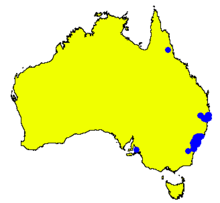Angophora bakeri
Angophora bakeri, commonly known as the narrow-leaved apple,[2] is a species of tree that is endemic to New South Wales. It has rough, fibrous bark on the trunk and branches, lance-shaped adult leaves, flower buds in groups of three or seven, white or creamy white flowers and oval to cylindrical fruit.
| Narrow-leaved apple | |
|---|---|
.jpg) | |
| Flower buds of Angophora bakeri in Jannali | |
| Scientific classification | |
| Kingdom: | Plantae |
| Clade: | Tracheophytes |
| Clade: | Angiosperms |
| Clade: | Eudicots |
| Clade: | Rosids |
| Order: | Myrtales |
| Family: | Myrtaceae |
| Genus: | Angophora |
| Species: | A. bakeri |
| Binomial name | |
| Angophora bakeri | |
 | |
| Occurrence data from AVH | |
Description
Angophora bakeri is a tree that typically grows to a height of 10–18 m (33–59 ft) and forms a lignotuber. It has rough, fibrous grey bark on the trunk and branches. Young plants and coppice regrowth have linear to narrow lance-shaped leaves that are more or less sessile, 50–100 mm (2.0–3.9 in) long, 4–10 mm (0.16–0.39 in) wide and arranged in opposite pairs. Adult leaves are thin, glossy green, paler on the lower surface, linear to narrow lance-shaped, 60–130 mm (2.4–5.1 in) long, 5–10 mm (0.20–0.39 in) wide on a petiole 3–10 mm (0.12–0.39 in) long, and arranged in opposite pairs. The flower buds are arranged on the ends of branchlets in groups of three or seven on a peduncle 7–18 mm (0.28–0.71 in) long, the individual buds on pedicels 4–11 mm (0.16–0.43 in) long. Mature buds are 4–5 mm (0.16–0.20 in) long and 4–6 mm (0.16–0.24 in) wide. There are five sepals up to 1 mm (0.039 in) long and the petals are about 3 mm (0.12 in) long and wide. Flowering occurs from December to February and the flowers are white or creamy white. The fruit is an oval to cylindrical, pale brown or grey capsule 8–10 mm (0.31–0.39 in) long and wide with ribbed sides.[2][3][4]
Taxonomy and naming
Angophora bakeri was first formally described in 1913 by Edwin Cuthbert Hall in the Journal and Proceedings of the Royal Society of New South Wales.[5][6] The specific epithet honours Richard Thomas Baker.[4]
In 1986, G.J.Leach described two subspecies in the journalTelopea and the names have been accepted by the Australian Plant Census:[7]
- Angophora bakeri subsp. bakeri [8] has thin, flexible leaves and is widely distributed;[4]
- Angophora bakeri subsp. crassifolia G.J.Leach[9] has rigid, relatively thick leaves and is mostly only known from the Ku-ring-gai Chase National Park.[4]
Distribution and habitat
Narrow-leaved apple grows in sandy soil over sandstone and is widespread and locally abundant from Port Stephens to Nowra and as far west as Katoomba. There is also a disjunct population, previously known as Angophora exul, now a synonym of A. bakeri subsp. bakeri in the Gibraltar Range National Park.[2][4][3]
References
- "Angophora bakeri". Australian Plant Census. Retrieved 4 March 2020.
- Hill, Ken. "Angophora bakeri". Royal Botanic Garden Sydney. Retrieved 4 March 2020.
- Chippendale, George M. "Angophora bakeri". Australian Biological Resources Study, Department of Agriculture, Water and the Environment, Canberra. Retrieved 4 March 2020.
- "Angophora bakeri subsp. bakeri". Euclid: Centre for Australian National Biodiversity Research. Retrieved 5 June 2020.
- "Angophora bakeri". APNI. Retrieved 4 March 2020.
- Hall, Edwin C. (1913). "The seedlings of the Angophoras, and descriptions of a new species". Journal and Proceedings of the Royal Society of New South Wales. 47: 101–105. Retrieved 4 March 2020.
- Leach, Gregory J. (1986). "A Revision of the genus Angophora (Myrtaceae)". Telopea. 2 (6): 749–779. Retrieved 4 March 2020.
- "Angophora bakeri subsp. bakeri". Australian Plant Census. Retrieved 4 March 2020.
- "Angophora bakeri subsp. crassifolia". Australian Plant Census. Retrieved 4 March 2020.